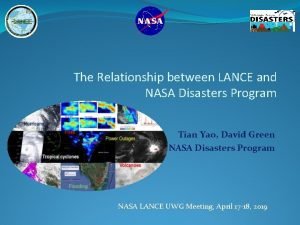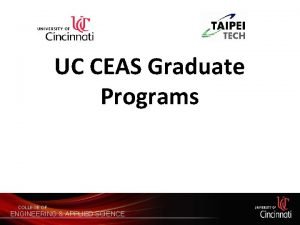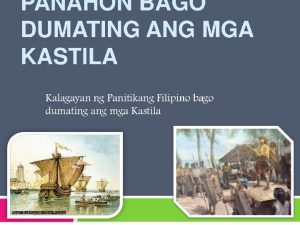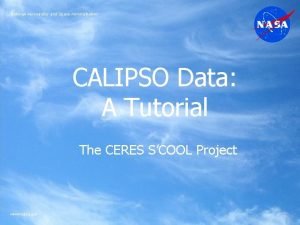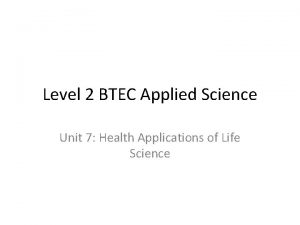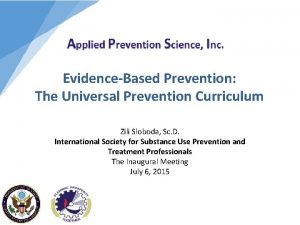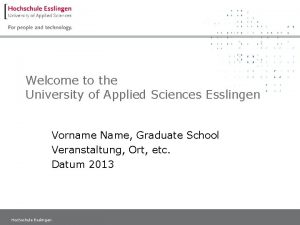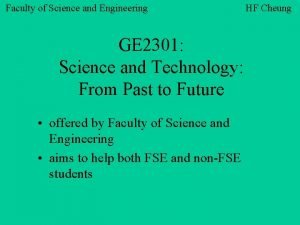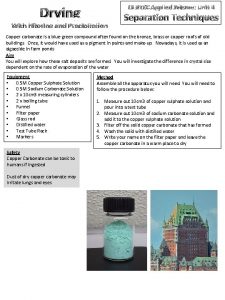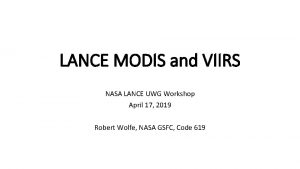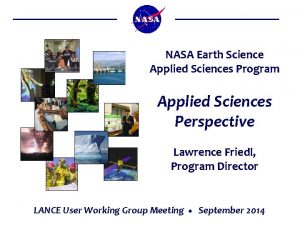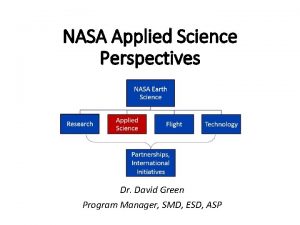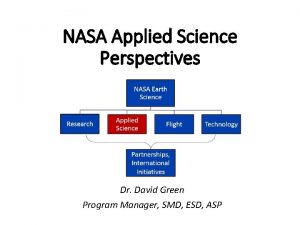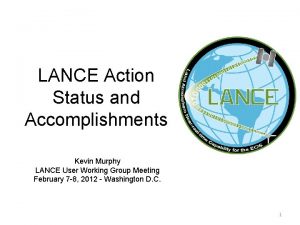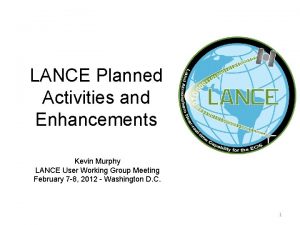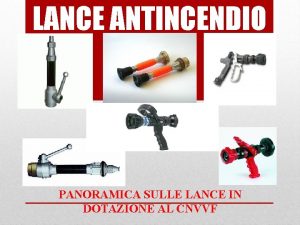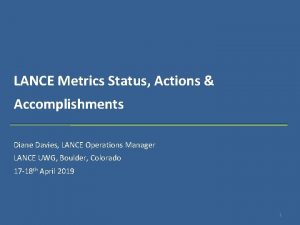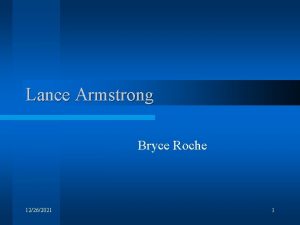NASA Applied Science Program and NASA LANCE David













- Slides: 13

NASA Applied Science Program and NASA LANCE David Green (Program Manager, NASA Disaster Program) 1

The value and requirements of LANCE across the Applied Science Programs • • Water Resources and Food Systems Health & Air Quality Energy Ecological Forecasting 2

The value and requirements of LANCE in Water Resources and Food Systems • Requirements for Near Real Time Data The required latency for identifying agricultural drought is within 24 hours. • Applications of Near Real Time Data Agriculture monitoring: Famine Early Warning Systems Network (FEWSNET) uses LANCE MODIS surface reflectance and MODIS land surface temperature as model inputs to monitor crop condition for food security; Geo. GLAM Crop Monitor uses LANCE MODIS surface reflectance and vegetation indices to monitor crop to enhance crop production projections. Snow monitoring, water quality and water supply monitoring: LANCE MODIS near real-time surface reflectance and vegetation indices are helpful to monitor snow, water quality nutrients and sediments. Meteorological applications: Naval Research Laboratory uses LANCE AMSR 2 surface precipitation and cloud liquid water over ocean products for meteorological applications; National Weather Service(NWS) and NOAA use Lightning Imaging Sensor (LIS) product to improve short-term weather forecasting. 3

The value and requirements of LANCE in Water Resources and Food Systems (continued) • Existing Products in LANCE MODIS/VIIRS snow cover product; AMSR 2 snow product; MODIS/VIIRS albedo product; MODIS/VIIRS land surface temperature product; MODIS/VIIRS surface reflectance product; MODIS vegetation indices products. • Potentially transitioning products to LANCE 1) SMAP soil moisture products. 2) Evapotranspiration (ET) products from water resources projects. 3) Harmful algal blooms (HAB) products: bloom location and spatial coverage, satellite chlorophyll estimates. • Opportunities for future development 1) NASA derived ice and snow products from MODIS do not meet the needs of commercial and public navigation requirements. 2) Soil moisture product from NASA ISRO Synthetic Aperture Radar (NISAR) mission would be useful in water resources management and food security. 3) The future satellite Surface Water Ocean Topography (SWOT) data would be useful in agriculture monitoring. 4

The value and requirements of LANCE in Health & Air Quality • Requirements for Near Real Time Data The Environmental Protection Agency (EPA) and air quality community need hourly PM 2. 5 data to enable better NRT monitoring and data analysis. Timely delivery of PM 2. 5 for health applications would be used to inform the public and reduce exposure to hazardous air quality conditions across urban areas. The extreme heat and health community needs NRT (less than 3 hours) land surface temperature data in urban areas to create extreme heat vulnerability maps during heat waves. The environmental and public health community needs NRT fire data for health impacts of wildfire smoke. • Applications of Near Real Time Data Air quality monitoring: EPA Air. Now-Tech Navigator uses LANCE MODIS/VIIRS Corrected reflectance imagery and Aerosol Optical Depth products to monitor air quality. End-user expansion: NASA Worldview is often utilized by the community as a first introduction to NASA datasets; HAQAST had developed community tutorials: https: //haqast. org/nasa-tools/ 5

The value and requirements of LANCE in Health & Air Quality (continued) Existing Products in LANCE relevant for Health and Air Quality Aerosols Trace Gases Other Aerosol Index (OMI/OMPS) Sulfur Dioxide MODIS/VIIRS Imagery (AIRS/MLS/OMI/OMPS) AOD (MODIS) Ozone (MLS/OMPS) MODIS Cloud products AIRS Dust Score Nitrous oxide (MLS) Fire Detection (FIRMS) Nitric acid (MLS) Carbon Monoxide (AIRS/MLS/MOPITT) • Potentially transitioning products to LANCE Cloud-Aerosol LIDAR and Infrared Pathfinder Satellite Observations (CALIPSO) NRT products. • Opportunities for future development CALIPSO NRT products would be useful to improve aerosol forecasts to enhance health and air quality decision making. Strong community desire for NRT products from TEMPO and other geostationary AQ satellites (GEMS, Copernicus Sentinel 4). GOES NRT aerosol/fire data. Is this possible in collaboration with NOAA? 6

The value and requirements of near real-time data products in Energy • Requirements for Near Real Time Data Near real-time satellite observations (< 7 days latency) are utilized as inputs to NASA and NASA partner's decision support tools which support renewable energy resource management and improvements in energy efficiency, and policy decision making. • Applications of Near Real Time Data from NASA Langley Research Center Near real-time surface radiative flux data set provided from NASA Langley Research Center’s POWER (Prediction of Worldwide renewable Energy Resource) project support multiple decision support tools (DST) and models, such as Natural Resources Canada's RETScreen clean energy project. - POWER provides a conduit for CERES FLASHFLux daily averaged surface radiative fluxes and the GMAO’s FP-IT data products to be customized for energy and agricultural use. • Opportunities for future development The NASA’s Black Marble nighttime light NRT products, which will be available in LANCE soon, would be useful for electric companies in energy industry. Future improvements to the POWER web archive might include assessing LANCE products with the aim of reducing latency. 7

The value and requirements of LANCE in Ecological Forecasting • Requirements for Near Real Time Data It's important to quantify the importance of latency relative to Ecological Forecasting data products and applications. In various Ecological Forecasting applications such as forestry and fishery applications, there is a need of near real-time data within 24 hours. • Applications of Near Real Time Data Forest management: WRI Global Forest Watch uses LANCE MODIS/VIIRS fire products to monitor forests; Conservation International uses LANCE MODIS/VIIRS fire products to improve land use management. Fishery and oyster farm data collection and management: The new coming LANCE NRT night -time light product, NASA's Black Marble product suite, can be used by fishery agencies to detect fishing boat, which has the potential fishery applications to estimate fish stocks and identify illegal fishing. Other applications related to Ecological Forecasting: Mapping oil spills and air quality after fires and volcano eruptions using LANCE MODIS/VIIRS products. 8

The value and requirements of LANCE in Ecological Forecasting (continued) • Existing and New Products in LANCE MODIS/VIIRS Fire and Thermal Anomalies product; MODIS/VIIRS Surface Reflectance product; MODIS/VIIRS Land Surface Temperature product; MODIS/VIIRS albedo product; MODIS vegetation indices products; MODIS Volcano MODVOLC product; VIIRS Black Marble night-time light product suite. • Potentially transitioning products to LANCE Plant traits products such as vegetation phenology product. • Opportunities for future development Forest management community need near real-time land cover data within 24 hours, and thus they require access to NRT SAR products to reduce possible cloud contamination. 9

Application GIS Gaps and Needs • Disasters Mapping Portal Requirements of LANCE and DAACs • Data needs to be accessible to non-scientific community • Netcdf and hdf formats are not considered “analysis ready data” to emergency management GIS users, format is not user friendly to those without a remote sensing background • Floating point geotiff and shapefile are preferred by Disasters Mapping Portal and emergency management GIS users. • GIBS team needs to keep converting data to REST endpoints so data can be streamed into Esri environments, most agencies and states use Esri software. 10

Application GIS Gaps and Needs • MODIS Flood products transitioning to LANCE • Current outputs include geotiff format • Disasters Mapping Portal script ingests geotiff format to create near real-time product • MODIS Flood NRT product is extremely popular on Disasters Mapping Portal • LANCE version of MODIS flood products must include geotiff to maintain accessibility • Current categories of accessible data • Able to use – FIRMS – available as shapefile • Data is in LANCE but have to use gibs to access • people come to us during X event, they asked for esri compatible access to X dataset 11

• Current categories of accessible data • Able to use • FIRMS – available as shapefile • Data is in LANCE, currently accessing through GIBS • True and False Color Corrected Reflectance and Surface Reflectance from MODIS Aqua/Terra and SNPP VIIRS • Data is in LANCE, not able to easily utilize due to extra hurdles associated with access • True and False Color Corrected Reflectance and Surface Reflectance from NOAA-20 VIIRS • AMSR 2 (soil moisture and precipitation) • ISS LIS for lightning • OMPS SO 2 • MISR Plume Products 12

Thank you ! 13
 Lance nasa
Lance nasa Applied science vs pure science
Applied science vs pure science My favourite subject worksheet
My favourite subject worksheet Fu foundation school of engineering
Fu foundation school of engineering Uc college of engineering and applied science
Uc college of engineering and applied science Awitin kahulugan
Awitin kahulugan Calipso browse images
Calipso browse images Lone star college nursing program prerequisites
Lone star college nursing program prerequisites Btec applied science level 3 unit 7
Btec applied science level 3 unit 7 Applied prevention science international
Applied prevention science international Automotive engineering esslingen
Automotive engineering esslingen Importance of applied science
Importance of applied science Btec level 3 applied science unit 4 assignment b
Btec level 3 applied science unit 4 assignment b Applied medical science swansea
Applied medical science swansea
